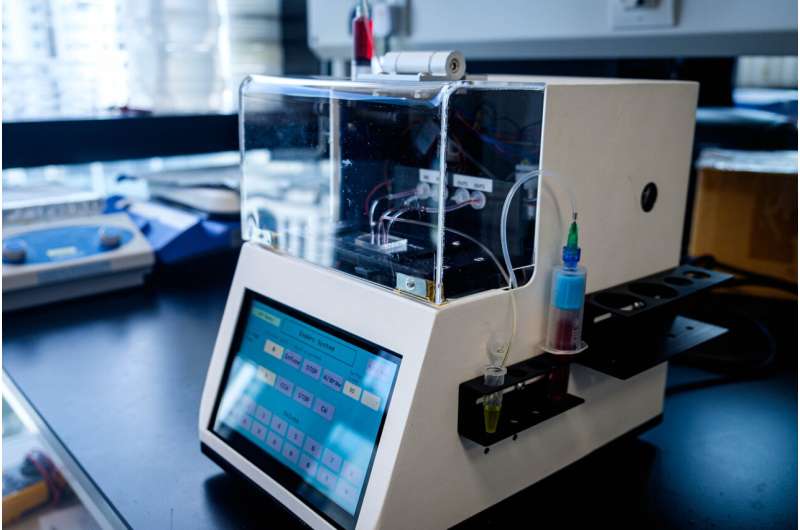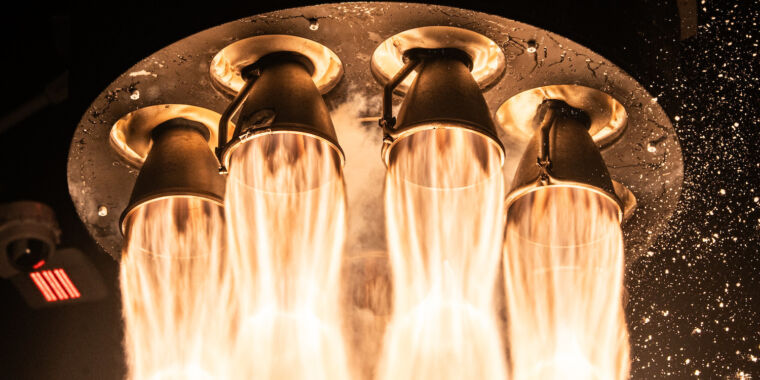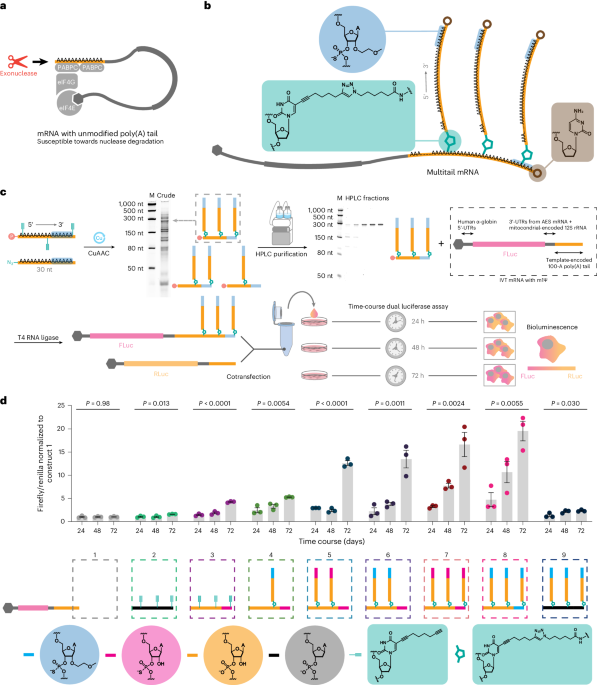[ad_1]

Scientists at Nanyang Technological University, Singapore (NTU Singapore), have developed a coin-sized chip that can directly isolate blood plasma from a tube of blood in just 30 minutes, which is more convenient and user-friendly as compared to the current gold standard, multi-step centrifugation process.
Named ExoArc, the device can achieve high blood plasma purity by removing more than 99.9% of blood cells and platelets precisely and gently in just one step.
This will greatly speed up clinical analysis of the cell-free DNA and RNA molecules, as well as nanoparticles commonly known as extracellular vesicles. These particles are often used to screen for biomarkers that are tell-tale signs specific to certain cancers and diseases.
Currently, the only way to isolate blood plasma is by using a centrifuge, which spins blood samples at high speeds to separate blood cells from plasma.
However, even after two rounds of spinning in the centrifuge, there will still be some cells and platelets present in the blood plasma which can break down or degrade, releasing additional bio-content, thus leading to unwanted materials that affect the accuracy of diagnostic tests.
As a proof of concept, the team built a portable prototype device (measuring 30 cm x 20 cm x 30 cm) to house the ExoArc chip (3.5 cm x 2.5 cm x 0.3 cm), which has a large touchscreen interface to adjust settings, as well as internal pumps and pipings for the processing of blood samples and collection of the isolated blood plasma.
Together with clinician-scientists from National Cancer Center Singapore (NCCS), Tan Tock Seng Hospital (TTSH), and the Agency for Science, Technology and Research (A*STAR), the team clinically validated ExoArc by analyzing the microRNA profile of blood plasma in healthy people and cancer patients using a biomarker panel and found it was able to diagnose non-small cell lung cancer with a sensitivity of 90%.
As an innovation, ExoArc currently has two patent applications filed through NTUitive, NTU’s innovation and enterprise company, and its study findings have been published recently in ACS Nano.
Lead scientist of the study, NTU Associate Professor Hou Han Wei, said the team aimed to find a quicker solution that could replace the centrifuge, while still yielding high-quality plasma for disease screening and research.
“It has been nearly 160 years since the invention of the first centrifuge and about 50 years since modern high-speed centrifuges became a standard tool in laboratories for preparing blood samples. Despite these advancements, separating complex liquids like blood, which comprises various cell types and a diverse range of biological materials, remains a challenge,” explained Assoc Prof Hou, a biomedical engineer from the School of Mechanical and Aerospace Engineering and Lee Kong Chian School of Medicine (LKCMedicine).
“By leveraging unique flow phenomenon in tiny channels in a chip that is about the size of a dollar coin, we can now efficiently separate small biological materials based on their size without using any physical membrane or filters. We have transformed this breakthrough technology into a device about size of a small desktop printer, featuring disposable plastic chips to prevent cross-contamination in clinical testing.”
Co-author of the paper, Professor Darren Lim, senior consultant in the Division of Medical Oncology at NCCS and Director of Research at the SingHealth Duke-NUS Lung Center, explained the importance of high-quality blood plasma.
“Reducing contamination from degraded blood cells is crucial for the accuracy of diagnostic tests. Our study shows that this device allows quicker and more precise clinical diagnoses, significantly decreasing the waiting time for test results, reducing patients’ anxiety and ultimately improving their overall care. This is particularly significant for cancer treatment,” said Prof Lim.
In another demonstration of its broad application, the team used ExoArc to study microRNA molecules from blood plasma samples from healthy individuals and those with type 2 diabetes mellitus using quantitative polymerase chain reaction (PCR).
From just one tube of blood, they identified 293 different microRNA molecules. The research team also found that the microRNA profile from plasmas and extracellular vesicles from individuals with type 2 diabetes had a different composition as compared to healthy participants. This suggests the potential of ExoArc in helping to isolate and identify disease-related biomarkers.
Associate Professor Rinkoo Dalan, Senior Consultant specializing in diabetes and endocrinology at Tan Tock Seng Hospital, said the initial results are promising and show the potential of ExoArc being able to help drive precision medicine.
“This technology can help clinicians better predict and manage complications of chronic metabolic conditions like diabetes, by providing more accurate, timely, and individualized information. By detecting specific biomarkers accurately, we can tailor treatments to the unique needs of each patient, potentially improving outcomes and enhancing the quality of care,” said Assoc Prof Dalan, who is also a teaching faculty at LKCmedicine.
ExoArc vs. conventional centrifuge
The current gold-standard method of isolating blood plasma relies on centrifuges, which is not foolproof and is highly dependent on the skill of the technicians who manually extract the plasma after each spin.
Even after two centrifugation rounds, which can take up to an hour, residual biological cells can remain in the plasma, potentially contaminating RNA tests and leading to inaccurate results.
One of the key reasons is that blood tests are time-sensitive, requiring processing within a day or even a few hours to prevent the rapid degradation of biological material from cells. This breakdown introduces additional DNA, RNA or vesicles into the plasma, which can distort test outcomes.
Laboratories typically wait to accumulate multiple blood samples before using the centrifuge, extending the isolation process by several hours. This delay combined with the extended duration of centrifugation and operator variability, sometimes makes it challenging to compare scientific findings between different research labs.
Unlike the centrifuge machine which usually processes multiple tubes of blood samples, ExoArc technology can be scaled up by designing multiple channels to simultaneously isolate blood plasma as and when blood samples are received in clinics or hospitals in a faster and more consistent manner.
In the future, this process could be automated into a one-step process, which would significantly reduce the time needed to prepare samples for testing and will streamline the diagnostic process, potentially helping to reduce overall cost. By adjusting the size cutoff, this platform technology can also be used to isolate bacteria or viruses from blood or other biofluids.
The development of ExoArc is backed by a Proof-of-Concept and Proof-of-Value grant from the NTUitive Gap Fund, under the NTU Innovation and Entrepreneurship initiative. This initiative seeks to turn research into practical innovations that address societal challenges, like an aging population, and generate significant economic benefits for Singapore.
More information:
Sheng Yuan Leong et al, High-Throughput Microfluidic Extraction of Platelet-free Plasma for MicroRNA and Extracellular Vesicle Analysis, ACS Nano (2024). DOI: 10.1021/acsnano.3c12862
Provided by
Nanyang Technological University
Citation:
Scientists invent coin-sized device to rapidly isolate blood plasma for diagnostics and precision medicine (2024, March 21)
retrieved 21 March 2024
from https://phys.org/news/2024-03-scientists-coin-sized-device-rapidly.html
This document is subject to copyright. Apart from any fair dealing for the purpose of private study or research, no
part may be reproduced without the written permission. The content is provided for information purposes only.
Maqvi News #Maqvi #Maqvinews #Maqvi_news #Maqvi#News #info@maqvi.com
[ad_2]
Source link

















































